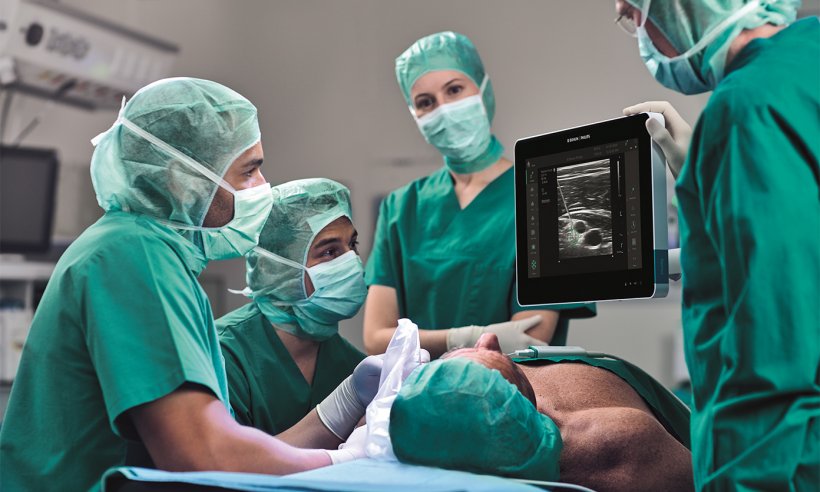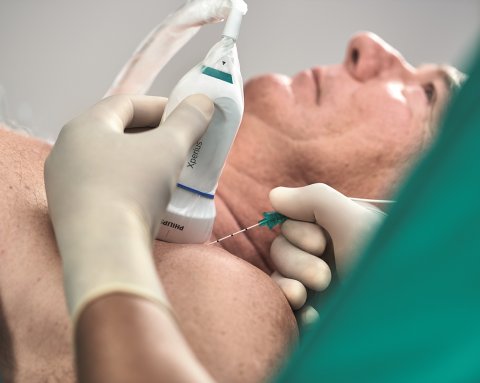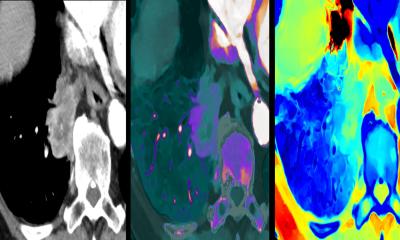
Source: Philips
News • Onvision needle tip tracking
A breakthrough in real-time ultrasound guidance for regional anesthesia
Royal Philips and B. Braun Melsungen AG announced the launch of Onvision, a breakthrough ultrasound guidance solution for real-time needle tip tracking in regional anesthesia.
Available on the latest version of the B. Braun and Philips Xperius ultrasound system, Onvision gives anesthesiologists the confidence to accurately position the needle tip inside the body. The introduction is part of a multi-year strategic alliance between Philips and B. Braun to innovate in ultrasound-guided regional anesthesia, a rapidly growing alternative to general anesthesia. Onvision is being launched at the 38th Annual Conference of the European Society of Regional Anaesthesia and Pain Therapy (ESRA) in Bilbao, Spain (11-14 September).

Accurate needle placement is critical to the success of regional anesthesia procedures, such as peripheral nerve blocks, both in terms of effective pain relief and the avoidance of unintended nerve and vessel punctures or collateral damage to surrounding tissue. While real-time ultrasound imaging has proved to be a valuable tool for needle guidance, failure to optimally visualize the needle tip remains a challenge for both novice [Sites et al., Regional Anaesthesia & Pain Medicine 2007] and experienced anesthetists [Chapman et al., Anaesthesia 2006] Currently, 10-20% of all peripheral nerve blocks are ineffective on the first attempt [Bartusseck et al., Der Anaesthesist 2004]. By simplifying alignment between the needle and ultrasound probe, Onvision reduces the effort needed to interpret the ultrasound image. This allows the anesthesiologist to more confidently guide the tip of the needle to its target.
Our customers want intuitive solutions that allow them to focus on the patient rather than the technology, so they can achieve the best outcomes
Meinrad Lugan
“Regional anesthesia is a rapidly growing alternative to general anesthesia and has the potential to improve patient outcomes as well as increase workflow efficiency in the hospital,” said Bert van Meurs, Chief Business Leader, Image Guided Therapy at Royal Philips. “By combining B. Braun’s expertise in needle design with Philips’ capabilities in real-time image guidance, we’ve created a solution to one of the biggest challenges in regional anesthesia – accurate positioning of the needle tip in the body. Our alliance with B. Braun is a strong example of our commitment to partner with industry leaders to grow our footprint in the therapy market.”
“Our customers want intuitive solutions that allow them to focus on the patient rather than the technology, so they can achieve the best outcomes. As demand for regional anesthesia grows, improved efficiency can also help reduce the pressure of an increasing workload,” said Dr. Meinrad Lugan, Member of the Board for the Hospital Care Division at B. Braun. “Onvision is a perfect example of what can be achieved through shared expertise to meet the evolving needs of our customers, bringing regional anesthesia to more patients in more hospitals worldwide.”
Together, B. Braun’s Stimuplex Onvision needles and Philips’ Onvision needle tip tracking technology indicate the position of the needle tip in relation to the ultrasound viewing plane to an accuracy of better than 3mm. A sensitive micro-sensor placed on the needle, combined with advanced signal processing and visualization techniques on the Xperius system, indicate the real-time location of the needle tip in relation to the 2D ultrasound viewing plane. The solution provides greater flexibility in needle trajectory and can reduce procedure times [Kåsine et al., Anaesthesiologica Scandinavia 2019]. The increased confidence and predictability offered by Xperius and Onvision will empower more anesthesiologists to embrace regional anesthesia as a viable and effective alternative to general anesthesia.
Regional anesthesia or analgesia involves the injection of an anesthetic in the proximity of a nerve, targeting areas of a patient’s body that are subject to surgical intervention. Regional anesthesia can have significant advantages over general anesthesia for both patients and hospitals. Patients undergoing regional anesthesia typically benefit from reduced opioid consumption and fewer side-effects, such as nausea. Moreover, regional anesthesia may lead to faster post-surgical recovery, allowing patients to ambulate or leave the hospital sooner, which benefits both patients and hospitals.
Together, Xperius and Onvision form an integrated point-of-care solution for supporting current and future needs in regional anesthesia. They are co-branded and sold via B. Braun’s global sales network, with Philips providing installation and service. Xperius is part of Philips’ complete portfolio of point-of-care ultrasound solutions, which offers clinicians the ability to confidently diagnose and care for their patients in any work environment.
Source: Philips
10.09.2019











